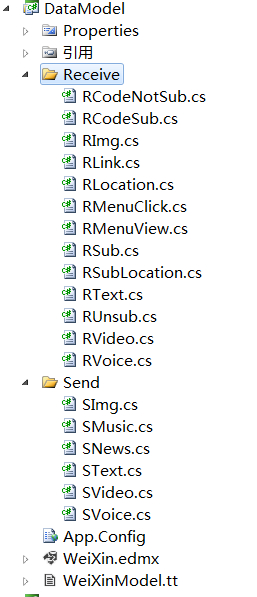asp.net开发微信公众平台(3)微信消息封装及反射赋值
上一篇已经搭建好整体框架,实现了入口的验证, 验证通过后就交给LookMsgType方法处理,LookMsgType方法主要是对微信发来的不同的消息进行分解,不同的类型交给业务逻辑层不同的方法处理, 对不同类型的消息判断,可以用if,也可以用switch 一般来说超过5个的if用switch会更好, 这里贴出LookMsgType方法:
public void LookMsgType(string msgType)
{
#region 判断消息类型
switch (msgType)
{
case "text":
RText mText = new RText();
mText = ReadXml.GetModel<RText>(mText, xmlModel);
BLLWei.DoText(dbHome, mText);//文本消息
break;
case "image":
RImg mImg = new RImg();
mImg = ReadXml.GetModel<RImg>(mImg, xmlModel);
BLLWei.DoImg(dbHome,mImg);//图片
break;
case "voice": //声音
RVoice mVoice = new RVoice();
mVoice = ReadXml.GetModel<RVoice>(mVoice, xmlModel);
BLLWei.DoVoice(dbHome,mVoice);
break;
case "video"://视频
RVideo mVideo = new RVideo();
mVideo = ReadXml.GetModel<RVideo>(mVideo, xmlModel);
BLLWei.DoVideo(dbHome, mVideo);
break;
case "location"://地理位置
RLocation mLocation = new RLocation();
mLocation = ReadXml.GetModel<RLocation>(mLocation, xmlModel);
BLLWei.DoLocation(dbHome,mLocation);
break;
case "link"://链接
RLink mLink = new RLink();
mLink = ReadXml.GetModel<RLink>(mLink, xmlModel);
BLLWei.DoLink(dbHome,mLink);
break;
#region 事件
case "event":
switch (ReadXml.ReadModel("Event", xmlModel))
{
case "subscribe":
if (ReadXml.ReadModel("EventKey", xmlModel).IndexOf("qrscene_") >= 0)
{
RCodeNotSub mNotSub = new RCodeNotSub();
mNotSub = ReadXml.GetModel<RCodeNotSub>(mNotSub, xmlModel);
BLLWei.DoCodeNotSub(dbHome,mNotSub);//未关注的新用户,扫描带参数的二维码关注
}
else
{
RSub mSub = new RSub();
mSub = ReadXml.GetModel<RSub>(mSub, xmlModel);
BLLWei.DoSub(dbHome,mSub);//普通关注
}
break;
case "unsubscribe":
RUnsub mUnSub = new RUnsub ();
mUnSub = ReadXml.GetModel<RUnsub>(mUnSub, xmlModel);
BLLWei.DoUnSub(dbHome,mUnSub);//取消关注
break;
case "SCAN":
RCodeSub mCodeSub = new RCodeSub();
mCodeSub = ReadXml.GetModel<RCodeSub>(mCodeSub, xmlModel);
BLLWei.DoCodeSub(dbHome,mCodeSub);//已经关注的用户扫描带参数的二维码
break;
case "LOCATION"://用户上报地理位置
RSubLocation mSubLoc = new RSubLocation();
mSubLoc = ReadXml.GetModel<RSubLocation>(mSubLoc, xmlModel);
BLLWei.DoSubLocation(dbHome, mSubLoc);
break;
case "CLICK"://自定义菜单点击
RMenuClick mMenuClk = new RMenuClick();
mMenuClk = ReadXml.GetModel<RMenuClick>(mMenuClk, xmlModel);
BLLWei.DoMenuClick(dbHome, mMenuClk);
break;
case "VIEW"://自定义菜单跳转事件
RMenuView mMenuVw = new RMenuView();
mMenuVw = ReadXml.GetModel<RMenuView>(mMenuVw, xmlModel);
BLLWei.DoMenuView(dbHome, mMenuVw);
break;
};
break;
#endregion
}
#endregion
}外层switch判断msgtype, 在event类型时,再次switch判断具体的事件类型(关注、取消关注、自定义菜单事件等), 至此所有的微信发来的消息都有处理了,在上面代码中用到消息模型以及ReadXml.GetModel方法给模型赋值, 赋值之后传递给业务逻辑层对应的方法处理, 下面写出消息封装和给模型赋值的方法。
1、消息封装:
对所有微信发来的消息进行封装, 在datamodel中建一个Receive文件夹和一个send文件夹,在其中分别建立对应消息的类,完成之后,完整的datamodel类库如下图:

举例
-----接收消息:
文本消息RText.cs
public class RText
{
public string ToUserName { get; set; }// 开发者微信号
public string FromUserName { get; set; }// 用户号(OpenID)
public long CreateTime { get; set; }// 创建时间
public string MsgType { get; set; } //消息类型
public string Content { get; set; }//内容
public long MsgId { get; set; }//消息ID
}自定义菜单点击RMenuClick.cs
public class RMenuClick
{
public string ToUserName { get; set; }// 开发者微信号
public string FromUserName { get; set; }// 用户号(OpenID)
public long CreateTime { get; set; }// 创建时间
public string MsgType { get; set; } //消息类型
public string Event { get; set; }//事件类型
public string EventKey { get; set; }//事件key
}其他也都类似,不一一列举。
-----发送消息
发送文本消息SText.cs
public class SText
{
public string ToUserName { get; set; }// 用户号(OpenID)
public string FromUserName { get; set; }// 开发者微信号
public long CreateTime { get; set; }// 创建时间
public string MsgType { get { return "text"; } } //消息类型
public string Content { get; set; }//内容
}
SText发送图文消息SNews.cs
namespace DataModel.Send
{
public class SNews
{
public string ToUserName { get; set; }// 用户号(OpenID)
public string FromUserName { get; set; }// 开发者微信号
public long CreateTime { get; set; }// 创建时间
public string MsgType { get { return "news"; } } //消息类型
public int ArticleCount { get; set; }//图文个数
public List<ArticlesModel> Articles { get; set; }//图文列表
}
public class ArticlesModel //默认第一条大图显示
{
public string Title { get; set; }//标题
public string Description { get; set; }//描述
public string PicUrl { get; set; }//图片链接
public string Url { get; set; }//点击之后跳转的链接
}
}在发送图文消息中,因为回复给微信的图文消息中,具体的图文内容是多条(最多可以10条),所以单独会有ArticlesModel。 后面文章会写出图文消息的发送。
2、通过反射给model赋值
在上篇文章写的入口处,已经有了解析xml的方法,现在封装了消息,通常的做法,是每次用到对应的model就手动写代码赋值, 而我这里LookMsgType方法中所有给消息赋值时全用的ReadXml.GetModel这同一个方法, 这里用的就是反射,方法如下:
/// <summary>
/// 通过反射给接收消息model赋值
/// </summary>
/// <typeparam name="T"></typeparam>
/// <param name="model"></param>
/// <returns></returns>
public static T GetModel<T>(T model, Dictionary<string, string> xmlModel) where T : class
{
var m = model.GetType();
foreach (PropertyInfo p in m.GetProperties())
{
string name = p.Name;
if (xmlModel.Keys.Contains(name))
{
string value=xmlModel.Where(x => x.Key == name).FirstOrDefault().Value;
p.SetValue(model,
string.IsNullOrEmpty(value) ? null : Convert.ChangeType(value, p.PropertyType), null);
}
}
return model;
}T model 就是要使用的消息类, xmlmodel是在入口处传递进来的解析的微信发来的xml信息, 这样,就不需要每次手动写代码赋值了。
好了,此篇实现了lookmsgtype方法, 实现了消息封装和反射赋值, 接下去就是到了业务逻辑层中的处理和具体实现了...
更多asp.net开发微信公众平台(3)微信消息封装及反射赋值相关文章请关注PHP中文网!

热AI工具

Undresser.AI Undress
人工智能驱动的应用程序,用于创建逼真的裸体照片

AI Clothes Remover
用于从照片中去除衣服的在线人工智能工具。

Undress AI Tool
免费脱衣服图片

Clothoff.io
AI脱衣机

AI Hentai Generator
免费生成ai无尽的。

热门文章

热工具

记事本++7.3.1
好用且免费的代码编辑器

SublimeText3汉化版
中文版,非常好用

禅工作室 13.0.1
功能强大的PHP集成开发环境

Dreamweaver CS6
视觉化网页开发工具

SublimeText3 Mac版
神级代码编辑软件(SublimeText3)





